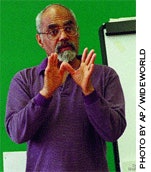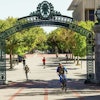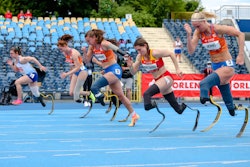A Real Fear
It’s more than stage fright. MATH anxiety can derail academic or professional success. But some scholars are working to help students get over it.
By Paul Ruffins
“Math anxiety is my worst enemy,” says Dr. Louise Raphael. “I feel that I am teaching the most important mathematics class on the Howard University campus, but my students’ fear of math is the toughest battle standing in my way.”

“I continuously have to confront attitudes like, ‘Nobody in my whole family can do math,’ or ‘You know our folks just aren’t good at this,’” Raphael says.
A third factor is slowly gaining attention as a possible cause of math anxiety: learning disabilities. Specialists who treat learning disabilities understand how these problems interfere with math skills, but discussions of learning disabilities have largely been absent from the academic research on math anxiety.
Math anxiety’s psychological symptoms include feeling nervous before a math class, panicking, going blank during a test or feeling helpless while doing homework. The physiological symptoms include sweaty palms, racing heartbeat or an upset stomach. The symptoms are essentially the same as stage fright, or the “butterflies in the stomach” athletes experience before a game. However, the critical difference between stage fright and math anxiety is that math represents the gateway to almost all forms of higher education and many career opportunities. Because of this, Bob Moses, a veteran of the Mississippi Freedom Summer, has defined math literacy as a civil rights issue and has organized The Algebra Project to help communities organize to demand better math education for low-income children.
For years, mainstream thinking about math anxiety assumed that people fear math because they are bad at it. However, a growing body of research shows a much more complicated relationship between math ability and anxiety. It is true that people who fear math have a tendency to avoid math-related classes, which decreases their math competence. However, many people with an aptitude for math suffer from anxiety that interferes with their ability to perform math-related tasks. In the June 2001 edition of the Journal of Experimental Psychology, Drs. Mark H. Ashcraft and Elizabeth P. Kirk, then at Cleveland State University, showed that anxiety interferes with short-term or “working” memory, which makes it harder to remember and simultaneously manipulate numbers.
Much of the research on math anxiety focuses on Blacks, Hispanics and women, all of whom exist under a societal stereotype that they are inherently less able to understand math and science. Shahid Muhammad, author of How to Teach Math to Black Students, says, “Perception of one’s abilities is directly related to academic performance. Since society has distorted and clouded Black students’ perceptions to the point that they cannot visualize Black people excelling in and mastering mathematics, they are comfortable with and satisfied with achieving at a below-average or average level in the math classroom.”
In 2001, Contemporary Educational Psychology published a study by Dr. Jason W. Osborne of the University of Oklahoma that concluded that cultural stereotypes about ethnicity and gender can severely undermine students’ confidence and abilities, particularly on timed tests. In an October 2006 edition of the magazine Science, Dr. Steven J. Heine and Ilan Dar-Nimrod, a professor and graduate student, respectively, at the University of British Columbia in Vancouver, confirmed Osborne’s results. They found that subtle suggestions of whether women’s math performance was a function of biology or environmental factors, had a profound impact on their test performance.
Science education writer Sheila Tobias’s book, Overcoming Math Anxiety, is widely considered the breakthrough work in the field. First published in 1978, Tobias argued that women’s underachievement in math resulted from a combination of self-perpetuating cultural and gender stereotypes. Among her findings: Girls lacked female role models in math and science; math teachers were consistently more likely to call on boys than girls; and being good at math was seen as unfeminine. She also argued that men’s superiority at visual-spacial tasks was due to the fact that young boys were more likely than girls to be given blocks and other building toys, and that encouraging boys to play sports gave them a better understanding of how objects move in time and space.
Tobias also made the critical observation that boys were encouraged to take more risks than girls, and tolerate making more mistakes. Therefore, while both boys and girls found that math was a difficult subject, boys felt they had to stick with it.
In understanding why well-educated, middle-class White women don’t do as well in math as their fathers and brothers, the explanations are limited to nature, nurture or societal expectation. Black and Hispanic students face the same issues as women, but their problems may be compounded by other issues that impact their education, such as disorganized family environments, poor nutrition or inexperienced teachers with over-crowded classrooms. As a result, there are differences in the types of interventions needed by middle-class women or minority college students and those needed by lower-income students.
Some of the most interesting research on helping the latter group has come from teachers who specialize in learning disabilities. Ann Hoover, director of tutoring for the Kingsbury School in Washington, D.C., says, “Of course having a skills deficit or a learning disability could make you psychologically anxious about math. However, a purely psychological approach to treating the anxiety won’t solve your disability.”
A key component to improving the performance of learning disabled students has been to focus on the language processing aspects of math. “How can a student possibly begin to solve a mathematical word problem if they lack the reading comprehension or grammar skills to really understand what the problem means?” asks Eleanor Wilson Orr, the author of Twice as Less, Black English and the Performance of Black Students in Mathematics and Science. Orr believes that the differences in word usage between Black spoken English and standard written language can seriously impair students’ ability to translate word problems into mathematical equations.
A Language of Logic
“My favorite weapon against math anxiety has been to use the fox, the goose and the bag of corn,” says Raphael. “I start my classes by actively engaging my students as collaborators in trying to solve a problem that breaks the common misperception that math is a set of computational skills when it is really a language of logic. Here’s the problem. A farmer is going to the market to sell a fox, a goose and a bag of corn. But he has to cross a river in a boat that is only big enough for him and one of the other three at the same time. If he leaves the fox and the goose alone, the fox will eat the goose. If he leaves the goose and the corn alone, the goose will eat the corn. I also encourage them to work like real professional mathematicians rather than students. This means taking as much time as they need and trying a lot of different approaches, including drawings, intuition and trial and error.”
Raphael’s approach of encouraging students to work on math problems in a group builds on the work of Dr. Uri Treisman, who the Harvard Foundation named the 2006 Scientist of the Year for his work in advancing the numbers and success of women and minorities in the sciences. In the 1970s, Treisman tried to discover why Black students at the University of California, Berkeley were having so much trouble in calculus classes compared to White and Chinese students. Treisman started out believing that their math problems correlated with low motivation, poor academic backgrounds, low income or a lack of parental support.
Treisman ultimately rejected all of these theories. Many of the Black students were highly motivated and came from families who prized education. The biggest difference was that the Black students tended to study alone, while most of the Chinese students got together to eat and study in groups after doing their individual homework. Treisman created a group study approach that has been successfully adopted at the University of Illinois, the University of Texas at Austin and other campuses. Between 1990 and 1998, the University of Kentucky’s “Math Excel: Calculus Among Friends” program doubled the number of low-income, women and minority students who got A’s and B’s in calculus at the calculus.
There are several reasons why working in groups is such a powerful tool against math anxiety. First, it solves almost all of the psychological issues identified by feminists: It provides peer role models and social support and debunks the idea that being good at math is unfeminine or “acting White.” It also offers an opportunity for many of the techniques Raphael recommends: allowing corrections without grading, showing alternative ways of solving problems and emphasizing staying with a problem until it is solved, rather than until time runs out.
The group approach has also been successful for non-traditional students. “Most of our students are working adults who started their education somewhere else, and many have some level of math anxiety,” says Randi S. Reich, provost of Strayer University. “We understand that fear of math does not at all point to a lack of ability, and we don’t use math scores to screen students out. We make group tutoring available to everyone on evenings and weekends, so there’s no excuse not to get the help you need.”
_______________________________________________
To Overcome Math Anxiety:
– Provide role models in the form of a highly qualified woman or minority instructor, and also introduce historical figures who were mathematicians or scientists
– Get a group of students to talk about a math problem before using numbers, mathematical symbols or equations. Show that even wrong answers can be useful in helping other people look at the problem
– Find a way to visualize a math problem in more concrete terms, perhaps using real life questions of size, distance, time or money
– Discuss the quantitative problem in terms of ordinary words or pictures
– Translate the problem into the formal English of mathematics
– Translate the formal description of the problem into mathematical terms and only then try to solve the mathematical equation
Solution: The key is realizing that the farmer can bring one of the items back. Take goose over, leaving fox with corn. Row back across and bring fox to side with goose. Leave fox and take goose back to the other side. Drop off goose on the first side, and then take the bag of corn over to the other side where it is safe with the fox. Go back to get the goose.
© Copyright 2005 by DiverseEducation.com
![Screenshot 2024 06 05 141719[91541]](https://img.diverseeducation.com/files/base/diverse/all/image/2024/06/Screenshot_2024_06_05_141719_91541_.66613a2803b85.png?auto=format%2Ccompress&fit=crop&h=107&q=70&w=160)




![Screenshot 2024 06 05 141719[91541]](https://img.diverseeducation.com/files/base/diverse/all/image/2024/06/Screenshot_2024_06_05_141719_91541_.66613a2803b85.png?auto=format%2Ccompress&fit=crop&h=167&q=70&w=250)












